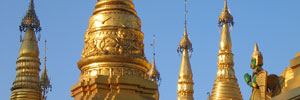
Day two in Myanmar and I was finally being stared at again! Even though I complained every day in China when the locals stared at me, I missed it when I left. There are so many tourists in Thailand that I wasn’t looked twice at. The most attention I could hope to get was from a tuk tuk driver trying to rip me off. I was nothing special. But here in Yangon people were interested in me–kids wanted to sell me postcards, diners watched me walk past, fruit vendors smiled.
Although Myanmar borders Thailand it couldn’t be more different. Men wore longyi, the sarong-like “skirt” and women didn’t wear pants. The men were thinner and women were heavier. One Chinese tourist told me that he had come to find a wife because the women had more curves. I was fascinated by the streets of Yangon, watching old men inspect jewels on the street corner next to my hotel and children playing soccer in-between passing cars. Click here to watch kids playing soccer below my hotel during the night. (Quicktime 1.4 mb)
I had saved an entire day for The Shwedagon Paya, Myanmar’s holiest Paya or Buddhist temple. After a breakfast buffet on the roof of my hotel I met a German man named Lutz who was heading in the same direction. Together we walked to the market, looking for the local bus that would take us North to The Shwedagon. It didn’t take too long before we flagged one down and tried to climb in the back. The man collecting fares directed us to the cab next to the driver–quite an honor. Jumping out, our money was refused and we headed toward The Shwedagon.
We could see the huge stupa rising up on the street in front of us, but decided to step into another paya along the way which looked interesting. The Maha Wizaya Paya was a newer building with entrance arches covered in surreal depictions of Buddha’s life. The circular corridor was lined with glass cases depicting the great cities of Myanmar, including Bagan and Inwa. What made this stupa special was the hollow center. Most stupas contain a relic (a tooth or hair from Buddha) in the center, which is covered and built upon. Local citizens contribute a large amount of their own money to construct payas, although some are fully funded by the government or a wealthy patron. By giving money a person is attempting to gain merit for themselves and their families in their next lives. I believe there a relic in this stupa but people could get close, sit around the center and pray.
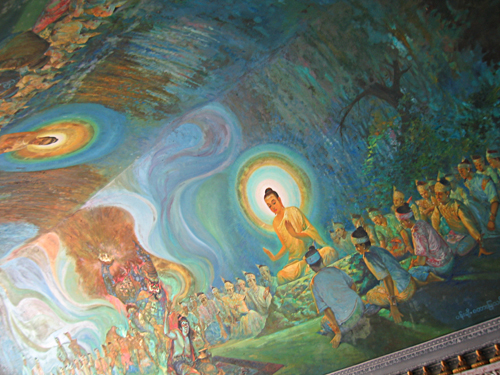
Psychedelic mural at Maha Wizaya Paya
Lutz and I walked outside the paya, put our shoes back on and made our way to the Shwedagon. Standing outside one of the four gates we were confronted by two 30-foot tall lions. These type of lions are seen all over Myanmar–printed on money, tattooed on monks and formed out of cement throughout temples. Before walking up the first step we took our shoes off for the second time that morning and put them in our bags. The actual paya is at the top of a small hill and we had entered a wide, covered walkway with steps leading up to the top. The walkway was lined with shops along both sides selling flowers, decorations, statues and other things that worshipers might want to buy to leave at the Shwedagon. Halfway up the stairs were were stopped and asked to pay the $5 entrance fee. As the most holy paya in Myanmar I am more than happy to pay an entrance fee but, unfortunately, this entrance fee is levied by the government and probably isn’t used to support the Shwedagon. Because of feels like this it is impossible to travel in Myanmar without contributing some money to the military junta that runs the country.
At the top of the long stairway the doorway opens up to reveal the 322 foot tall stupa, covered in gold leaf. Bamboo scaffolding surrounded the structure and workers climbed along the thin rods, preparing it to be covered with even more gold leaf. Although the stairs were relatively quiet the hilltop complex buzzed with activity. Worshipers walked clockwise seven times around the base and children played on the stone floor. Men kneeled before altars chanting and women showed their children how to pour water over statues of Buddha. Around the exterior of the stupa are astrological stations where Buddhists pray. Stupas generally have 8 stations–one station for each day of the week and two for Wednesday. Worshipers determine where they pray, light candles, leave flowers and so on by the day of the week they were born on. I had never heard of this tradition and hadn’t noticed it in any of the other predominately Buddhist countries I had visited. People asked me what day of the week I was born on and I had no idea. I have since learned that it was a Friday, which I seem to remember being one of the worst days. Each day is also represented by an animal which is usually featured on the shrine. Friday’s animal is a guinea pig which, although it isn’t as cool as the naga/serpent at least it’s not the rat.
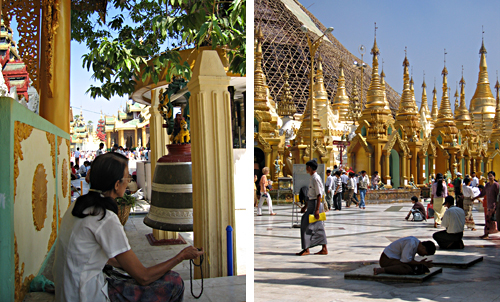
Worshipers around perimeter Shwedagon
This was Lutz’s second trip to Myanmar and he was determined to spend his time in The Shwedagon relaxing and people watching. It is an excellent place for both activities, and that’s precisely what most locals do. We wandered around the rest of the 52 hectacres, observing the local color. The paya seemed to serve as a community center where families gathered, friends gossiped and some people slept. Here (Quicktime 424 kb) you can see a short movie of a man teaching his small child how to ring a bell. Every direction I looked I saw more people and more buildings. Some of the buildings were small with only one statue. Some buildings were wooden and some were tiled or covered in mirrors. Each building had it’s own style and purpose.
After a while I started to get hungry and noticed the lack of any sort of food or vendors. Lutz and I had agreed to stay for sunset (the best light of the day for photography) and walked down the stairs to find some food. Walking across the road we were confronted with a strange sight–Happy Land! It was some sort of children’s theme park with every possible Western holiday symbol on display. We didn’t go inside after witnessing one of the attractions. Outside the entrance was a small merry-go-round playing the most annoying interpretation of Aqua’s song “My Oh My” I have ever heard. I could only assume that more of the same was inside and my hunger had already upset my stomach enough! I have a short video of this montrocity for my loyal readers here (Quicktime 292 kb — Warning! Extremely annoying!!). We managed an overpriced meal of rice and meat in the only restaurant in sight and headed back up The Shwedagon’s stairs.
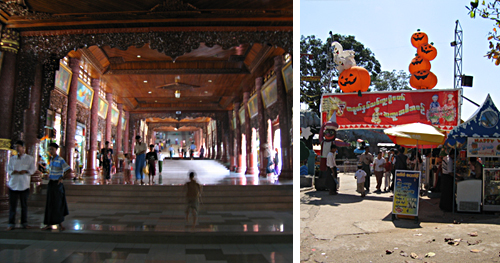
Entrance stairs to Shwedagon // Happy Land
For the rest of the afternoon Lutz and I wandered around the buildings, searching out the most interesting statues and worshipers. We stumbled upon one area, hidden away behind tarps that was full of half finished Buddha statues. The sculptor showed us the casts of the statue he was working on. In one of the taller buildings a two story seated Buddha was being fanned by worshipers on the ground via a long rope attached to a fan on the ceiling. I took a movie of it here (Quicktime 224 kb) but I’m an idiot and it’s sideways so you’ll have to use your imagination a bit.
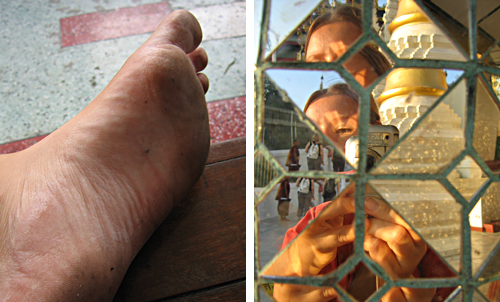
This is the cleanest my feet were in Myanmar // Self portrait
After an entire day of walking around the scorching hot marble floor my feet were sore and covered in dirt and candle wax. The locals must have had the same problem because suddenly a long line of people walked by, sweeping up the complex. Click here (Quicktime 788 kb) to see the sweepers in action. We had only seen a few other tourists (including one Western man wearing a longyi) throughout the day but as sunset neared the Shwedagon was overrun with an aging German tour group. As soon as we sat down we were surrounded by a group of four monks in maroon robes. The more outgoing monk cornered Lutz and asked about his camera. He showed me the lion tattoo on his forearm and I tried to be nice without being too nice.
A Westerner might assume that monks have the same ethics and commitment to their religion as Christian monks. Some do, but because of the Buddhist system in which every male is expected to become a monk a number of times throughout his life so many monks don’t follow the Buddhists precepts too closely. In my first day in Yangon I sat down at a paya and was joined by a monk. Because I had read that Buddhists monks can’t touch a woman or even be handed something I figured those rules would be especially strict in Myanmar–sometimes described at the most Buddhist country in the world. When the monk sat down I inched away a bit to give him space. After a few minutes of talking he had suddenly gotten closer to me and I inched away again. This continued until I reached the edge of the stoop! With this in mind I talked to the shy monk on my left who had the largest ears I have ever seen. I felt a bit sad for him when he said I shouldn’t take his picture because he is too ugly.
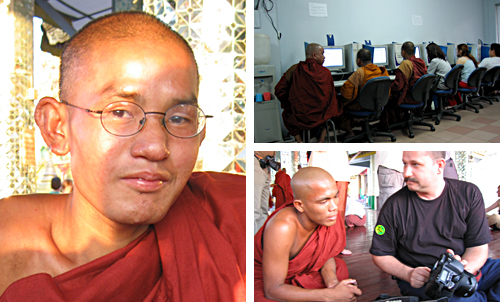
Monk with big ears // Techno-monks // Lutz showing Tattooed monk photos
When the sun set below the outer wall we picked ourselves off the floor, said goodbye to our new monk friends and headed out the way we came. The bus we caught on the way back was bursting at the seams. In fact, Lutz and I were the largest people by far and had a hard time squeezing into the doorway between all of the other passengers standing in the way. The fare collector hung out the door while we were driving and jumped off at each stop to let people on. Between stops he collected money from people which was passed around the bus. I’m not sure how he knew if someone paid, but I assume they work on the honor system. We had exact change (a small note worth almost nothing) and squeezed off at the right stop. It was dark off and the main street near our hotel had come alive. We passed by the internet shop where monks regularly check their email and ate dinner at a Burmese noodle shop where I drank my first of what would be many Star Colas. After my day at The Shwedagon I felt ready to conquer the rest of Myanmar.
You can see the photos from Yangon in the gallery.